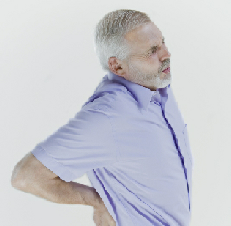
Menopause, Bio Identical Hormones, Sexual Health, Lack of Libido, Erection Problems, Gender Issues, Prostate Cancer, Psychiatry, Cancer

Common Chronic Conditions that Occur
In this section age-related changes have been described occurring in cartilage, bone and soft tissues. Here we will outline some features of the illnesses to which these changes may lead.
They cause considerable disability in older people: in terms of function there is loss of muscle strength, a reduced range of movement in the spine and peripheral joints, and loss of joint position sense (proprioception) leading to increasing difficulty in maintaining balance. Loss of bone density (osteoporosis) in the spine leads to bowing of the back (kyphosis) and loss of height. A person with this problem is fortunate if symptom free and more probably will have backache and stiffness.
Musculoskeletal pain is very common in this age group. For instance, nearly a quarter of people over 55 years of age describe themselves as currently having knee pain, while over the age of 70 nearly everyone has some stiffness and difficulty in initiating movement.
Changes in bone and soft tissue increase the risk of accidents. By far the commonest are fractures, but pain following trauma to joints and back are also very common.
Fractures are partly a consequence of bone fragility but also occur due to the increasing frequency of falls with age. The most common fractures are of vertebra, wrist and hip. The increase in frequency of hip fractures very late in life may be related to the tendency at this age, with loss of mobility and balance, to fall sideways onto the hip rather than forwards on to the outstretched arm.
Rheumatic disease in this population are common and is often not diagnosed or is under treated. It is classified as inflammatory arthritis, degenerative arthritis, connective tissue disease, soft tissue rheumatism and back pain. These represent the commonest cause of disability in people aged over 75 years while osteoarthritis is the single commonest form of joint disease amongst older people.
Rheumatoid arthritis is an inflammatory form of arthritis. It typically starts in the sixth decade and may co-exist with other conditions making its management more difficult. Genetic factors (complex polymorphisms) predispose to the condition. Persistent inflammation (inflammatory synovitis) is the key feature of joints, which are swollen, tender and stiff, particularly on waking. Usually joints are affected symmetrically ie on both sides of the body. Small joints of the hands, wrist and feet as well as, less often, knees, elbows and ankles
are involved. The course of the disease is very variable but, reassuringly, a study which followed-up rheumatoid patients for 15 years showed 60% had retained relatively normal function.
Osteoarthritis (OA), categorised as a degenerative arthritis, principally of weight-bearing joints such as the knee, is best considered as a condition of ‘joint failure’ for which there may be a number of underlying causes. These include over or under-use of the joint as well as trauma to it, infection, endocrine and metabolic disease. These have in common destruction of cartilage, exposure of bone and the predominant symptom of pain. There is notably little connection between the degree of joint damage in OA and the amount of pain experienced. Stiffness occurs, typically worse on waking and after rest.
Polymyalgia and temporal arteritis are two related examples of connective tissue disease. They present as painful shoulder and neck muscles in the case of polymyalgia and as severe and tender temporal headaches in temporal arteritis. Fortunately symptoms often remit spontaneously within eighteen months and can be controlled by the use of steroids.
Gout causes an inflammatory synovitis in joints due to the precipitation of crystals of urate. Classically the first joint of the big toe (metatarsophalangeal joint) is affected but the condition can occur in many joints. The abrupt onset and exquisite nature of the pain as well as the redness that surrounds the affected joint make it easy to recognise. Typically the age of onset is in the 40’s; women are rarely affected unless taking diuretics. A genetic factor predisposes to the condition while excess alcohol, dehydration and certain drugs may start an attack.
The Rotator cuff syndrome and Frozen shoulder are common examples of soft tissue rheumatism in older people. In the rotator cuff syndrome there is damage of the four tendinous insertions on to the head of the humerus. Damage is often a consequence of changes to collagen synthesis, reduced tensile strength in the tendons and loss of integrity of the joint capsule. Pain is the presenting symptom with weakness in movement at the shoulder joint.
With a Frozen shoulder there is contracture of the synovial capsule surrounding the joint with pain, stiffness and loss of movement in all planes. Often there is no history of trauma to the joint but there may be associated medical conditions such as diabetes, thyroid or lung disease.
Back pain often has a mechanical basis, due to lumber spondylosis, osteoporosis or, rarely, cancer. Deterioration in the quality of collagen fibres, loss of intervertebral space due to compression within the vertebral discs lead to loss of height and mechanical strain in the back.
